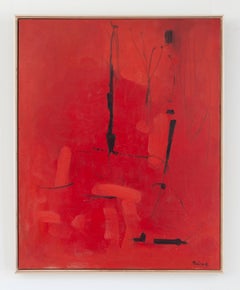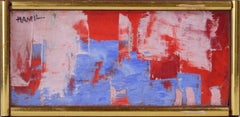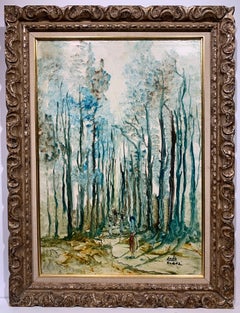Louis Ribak Art
American, 1902-1979
Louis Ribak emigrated with his family from Russian Poland to New York City in 1912. He studied at the Art Students League during the early 1920’s under John Sloan. Sloan was an editor for the radical periodical, New Masses, and prompted the young artist to illustrate for the publication. In 1929, Ribak’s involvement with New Masses led him to become a founding member of a closely associated group, the John Reed Club. Over the next few years he exhibited with the club and, in 1933, he received attention from critics including the New York Sun for his painting, Striking Farmers.
Ribak joined the Silk Screen Group in the late 1930’s as he believed, along with a group of liberal artists, that the print medium was the “people’s art of the twentieth century.” Also during the 1930’s, Ribak worked for the Works Progress Administration (WPA) as a muralist.
In 1942, he married fellow artist Beatrice Mandelman. In the mid 1940’s, the couple followed the advice of John Sloan and moved to New Mexico. The move was prompted in part by the desire for a healthier climate for Ribak but also because they felt a need to leave New York as they had become disillusioned by “dissention between Social Realists and Abstract Expressionists.”
In 1947, the Ribaks’ opened and instructed at the Taos Valley Art School. The school closed in 1953 when the couple returned to New York City. However, the move back to New York was short-lived and they settled permanently in Taos in 1956.
In 1959, the couple opened the Gallery Ribak in their home. The gallery showed their own work as well as that of other Taos artists. In addition to the gallery, Ribak regularly exhibited in other locations throughout the region.
In New Mexico, Ribak shifted his to focus entirely to full abstraction saying that as an artist he was “not truly anything. I am against everything. Damned abstract[ionists], realists, illustrators…”(Biography provided by David Cook Galleries)
to
3
1
3
2
1
Overall Height
to
Overall Width
to
3
3
1
3
6,958
3,331
2,514
1,213
3
2
2
2
2
Artist: Louis Ribak
Burning Woods
By Louis Ribak
Located in Austin, TX
Oil on masonite. Signed lower right and on verso.
30 x 24 in.
31 x 25 in. (framed)
Custom framed in maple.
Louis Leon Ribak was born in the Russian empirical governorate of Grodno in 1902. A long-disputed region that is ethnically Lithuanian, at present day, Grodno is located in the western reaches of the Republic of Belarus, near the borders with Poland and Lithuania.
At the age of ten, Ribak and his family immigrated to New York City. In 1922, he attended the Pennsylvania Academy of Fine Arts, followed by studies at the Art Students League (1923) and the Educational Alliance (1924).
Ribak’s oeuvre can be largely delineated between two stylistic phases: social realism and abstraction, the former taking hold during the 1930s and 40s. During that period, he had several solo exhibitions at the A.C.A. Gallery in New York, while also regularly exhibiting with “An American Group Inc.” - a cohort of socially-conscious painters that included Stuart Davis, Reginald Marsh, Maurice Sterne, and Raphael Soyer. In 1933, Ribak assisted Diego Rivera on the mural for the lobby of Rockefeller Center, while also being employed by the Works Progress Administration (WPA) as a muralist.
Louis Ribak met fellow artist Beatrice Mandelman at a dance sponsored by the Artists Union in New York. They were married in 1942, and shortly thereafter, he was drafted for military service in World War II.
After his discharge from the service in 1942 due to difficulties with asthma, Mandelman and Ribak traveled west to visit his former mentor John Sloan in Santa Fe, NM. By this time, the couple had become disenchanted with the art scene in New York, and in light of the need to find a healthier climate for Ribak’s asthma - as well as reputed FBI surveillance based on political affiliations with Communist sympathizers - they decided to permanently relocate to the emerging artists’ colony of Taos, NM in 1944. This change of scenery ushered in the second phase of Ribak’s stylistic career, with his work shifting from social realism toward abstraction. He was captivated by the landscape and the diverse cultures of northern New Mexico, the influences of which began to appear in his work.
Ribak founded the Taos Valley Art School in 1947, offering no ideology to his students; instead arguing that the adoption of a single approach would lead to academicism. Ribak was an integral force in the development of the Taos Moderns...
Category
1960s Abstract Louis Ribak Art
Materials
Masonite, Oil, Board
Personages of the Gorge
By Louis Ribak
Located in Santa Fe, NM
Watercolor and india ink on handmade paper
dimensions are framed size, frame has 1/4 gold leaf profile with wood sides
black red yellow
mid century modern
Louis Leon Ribak was born in the Lithuanian province of Grodno Gubernia in 1902. When he was ten, he immigrated with his family to New York City. In 1922 he attended the Pennsylvania Academy of Fine Arts, in 1923 studied with John Sloan at the Art Students League and at the Educational Alliance in 1924. Sloan's influence guided Ribak's development. As an editor for the radical periodical, New Masses, Sloan encouraged Ribak to illustrate for the publication. In 1929, Ribak become a founding member of the John Reed Club, a group closely associated with New Masses.
Ribak's work during the 1930s and early 1940s is dominated by social realism. His painting Coal Miners is in the permanent collection of the Jewish Museum, and Home Relief Station is in the permanent collection of the Whitney Museum of American Art.
In the early 1930s Ribak had several one-man exhibitions at the A.C.A Gallery in New York and regularly exhibited with "An American Group Inc.", a group of socially conscious painters including Stuart Davis, Reginald Marsh, Maurice Sterne, Raphael Soyer, and others. In 1933 he assisted Diego Rivera on the mural for the lobby of Rockefeller Center, and in 1935 worked for the Works Progress Administration (WPA) as a muralist. Ribak participated annually in the Whitney Museum's Exhibition of Contemporary American Art from its inception in 1932 until he left New York in 1944. In 1934 Ribak's work was chosen for the Venice Biennial.
Louis Ribak met Beatrice Mandelman at a dance sponsored by the Artists Union and in 1942 they married. That same year, he was drafted for military service, but 2 years later he was released from service due to asthma. In 1944 the couple traveled west to visit John Sloan in Santa Fe and shortly after, moved to Taos. The move was prompted in part by the need for a healthier climate for Ribak but also because they had become dissatisfied with the New York scene due to "dissention between Social Realists and Abstract Expressionists."
In New Mexico Ribak's artistic style underwent a transformation from Social Realism towards abstraction. He was captivated by the landscape and the diverse cultures of northern New Mexico. In 1947 Ribak founded the Taos Valley Art School. He offered no ideology to his students, arguing that taking any single approach would lead to academicism. Ribak was an integral force in the development of the Taos Moderns...
Category
20th Century Abstract Louis Ribak Art
Materials
India Ink, Watercolor, Handmade Paper
Untitled (Canyon)
By Louis Ribak
Located in Santa Fe, NM
Watercolor and india ink on handmade paper
black red yellow
mid century modern
Louis Leon Ribak was born in the Lithuanian province of Grodno Gubernia in 1902. When he was ten, he immigrated with his family to New York City. In 1922 he attended the Pennsylvania Academy of Fine Arts, in 1923 studied with John Sloan at the Art Students League and at the Educational Alliance in 1924. Sloan's influence guided Ribak's development. As an editor for the radical periodical, New Masses, Sloan encouraged Ribak to illustrate for the publication. In 1929, Ribak become a founding member of the John Reed Club, a group closely associated with New Masses.
Ribak's work during the 1930s and early 1940s is dominated by social realism. His painting Coal Miners is in the permanent collection of the Jewish Museum, and Home Relief Station is in the permanent collection of the Whitney Museum of American Art.
In the early 1930s Ribak had several one-man exhibitions at the A.C.A Gallery in New York and regularly exhibited with "An American Group Inc.", a group of socially conscious painters including Stuart Davis, Reginald Marsh, Maurice Sterne, Raphael Soyer, and others. In 1933 he assisted Diego Rivera on the mural for the lobby of Rockefeller Center, and in 1935 worked for the Works Progress Administration (WPA) as a muralist. Ribak participated annually in the Whitney Museum's Exhibition of Contemporary American Art from its inception in 1932 until he left New York in 1944. In 1934 Ribak's work was chosen for the Venice Biennial.
Louis Ribak met Beatrice Mandelman at a dance sponsored by the Artists Union and in 1942 they married. That same year, he was drafted for military service, but 2 years later he was released from service due to asthma. In 1944 the couple traveled west to visit John Sloan in Santa Fe and shortly after, moved to Taos. The move was prompted in part by the need for a healthier climate for Ribak but also because they had become dissatisfied with the New York scene due to "dissention between Social Realists and Abstract Expressionists."
In New Mexico Ribak's artistic style underwent a transformation from Social Realism towards abstraction. He was captivated by the landscape and the diverse cultures of northern New Mexico. In 1947 Ribak founded the Taos Valley Art School. He offered no ideology to his students, arguing that taking any single approach would lead to academicism. Ribak was an integral force in the development of the Taos Moderns...
Category
20th Century Abstract Louis Ribak Art
Materials
India Ink, Watercolor, Handmade Paper
Related Items
Out of the Blue, Miniature Red & Blue Abstract
By Tom Hamil
Located in Soquel, CA
Bright, small abstract expressionist painting of red, white and blue hues by California artist Tom Hamil (American, b. 1928). Signed upper left corner "Hamil". Condition: Excellent. Presented in rustic wooden shadow box frame. Image size: 2.75"H x 6.75"W.
Tom Hamil, was born in New York in 1928 and raised primarily in California. After attending the US Naval Academy in Annapolis, he returned to California to begin his formal art training at the California School of Fine Arts in San Francisco (now known as the San Francisco Art Institute). He completed his education at the University of Washington with a Master’s Degrees and Doctorate in Fine Arts and Education. His first solo exhibition was held in 1956. Since then, he has participated in numerous one man shows, group shows, and has been represented in galleries in the US and Mexico.
In addition to his painting, Hamil has authored and illustrated a number of books. While at the Naval Academy, he received recognition for his paintings, drawings, and illustrations. Listed among Hamil’s many awards and honors are a Ford Foundation Fellowship and an Award of Excellence from the American Graphics Society.
Currently, he lives in Zirahuen, Michoacan, Mexico and Truth or Consequences, New Mexico. Hamil’s statement: “I am a man...
Category
Mid-20th Century Abstract Expressionist Louis Ribak Art
Materials
Masonite, Oil
Landscape
By Andre Elbaz
Located in Wilton Manors, FL
Andre Elbaz (b.1934). Landscape, ca. 1980 . Oil on card panel, image measures 14 x 20 inches; 18.5 x 24.5 inches framed. Signed lower right. Excellent condition.
André Elbaz (born April 26, 1934, El Jadida, Morocco) is a famous Moroccan painter and filmmaker.
Elbaz studied art and theatre in Rabat and Paris from 1950 to 1961. He started painting only at the age of 21, until which age he had been interested mainly in theatre. A few years later, he managed to combine his two passions into a new approach in art-therapy, inventing together with his wife, a psychiatrist, the Pictodrame, which brought him world recognition.
His first exhibition, which was very successful, took place in Casablanca in 1961 and earned him an appointment as Professor at the Beaux-Arts school in Casablanca. Years later, in 1976, he exhibited his paintings at the Tel-Aviv Museum.
In parallel to his career as a painter, Elbaz is also known as a filmmaker. He produced several short films in France, Canada and the United States. One of them, La nuit n'est jamais complète (The night is never complete), won a prize at the "5th Biennale de Paris in 1967" .[citation needed] Among the themes chosen for the many films he produced, there was a short one about the Warsaw Ghetto uprising, as well as a series of drawings entitled Seuls (Alone), with texts written by both Elie Wiesel...
Category
1970s Abstract Louis Ribak Art
Materials
Masonite, Oil
Boats Near Shore - Abstracted Seascape
By Robert Canete
Located in Soquel, CA
Abstracted seascape of three boats near the shore with broad, painterly strokes of blue, turquoise, and neutrals by Robert Canete (American, b. 1948). Signed lower right. Image: 6"H ...
Category
1980s Abstract Expressionist Louis Ribak Art
Materials
Masonite, Oil
Landscape, Abstract Expressionist Painting by Alexander M. Bing
Located in Long Island City, NY
A fine period Abstract Expressionist oil painting by noted American artist, Alexander M. Bing (1878 - 1959), signed 'AMB' lower right. Gallery label from ...
Category
1950s Abstract Expressionist Louis Ribak Art
Materials
Masonite, Oil
Beneath The Evening Moon
Located in Clayton, MO
In Beneath The Evening Moon color, line, shape, and texture collide with handwritten romantic fragments of prose on Kozuke ivory paper. This one-of-a-kind, unmounted encaustic monoty...
Category
2010s Abstract Louis Ribak Art
Materials
Wax Crayon, India Ink, Encaustic, Archival Paper, Rice Paper, Pen, Color...
Abstract Portrait Painting by Peter Keil - Black & Tan
By Peter Keil
Located in Hudson, NY
A beautiful Peter Keil original painting. Keil's signature style is shown in these Picasso inspired portraits. These portraits are characteristic of Keil's work in the 1980s when the...
Category
Late 20th Century Abstract Louis Ribak Art
Materials
Masonite, Acrylic, Board
H 24 in W 12 in D 0.125 in
And His Open Arms Embraced
Located in Clayton, MO
In And His Open Arms Embraced color, line, shape, and texture collide with handwritten romantic fragments of prose on Kozuke ivory paper. This one-of-a-kind, unmounted encaustic mono...
Category
2010s Abstract Louis Ribak Art
Materials
Wax Crayon, India Ink, Encaustic, Archival Paper, Rice Paper, Pen, Color...
Colorful Portrait Painting on Board by Peter Keil w Tiffany Blue Background
By Peter Keil
Located in Hudson, NY
This modern abstract painting by Peter Keil is on a smooth masonite board with a painted Tiffany Blue background, black abstract portrait. Here you ...
Category
Late 20th Century Abstract Louis Ribak Art
Materials
Masonite, Acrylic, Board
H 24 in W 16 in D 0.25 in
In Memory Of What Has Been
Located in Clayton, MO
In Memory Of What Has Been color, line, shape, and texture collide with handwritten romantic fragments of prose on Kozuke ivory paper. This one-of-a-kind, unmounted encaustic monotyp...
Category
2010s Abstract Louis Ribak Art
Materials
Wax Crayon, India Ink, Encaustic, Archival Paper, Rice Paper, Pen, Color...
Amid The Blue Waves
Located in Clayton, MO
In Amid The Blue Waves color, line, shape, and texture collide with handwritten romantic fragments of prose on Kozuke ivory paper. This one-of-a-kind, unmounted encaustic monotype il...
Category
2010s Abstract Louis Ribak Art
Materials
Wax Crayon, Sumi Ink, India Ink, Encaustic, Archival Paper, Rice Paper, ...
Vintage Abstracted Sea Cave oil and Paper Collage
Located in Soquel, CA
Wonderful vintage multi-media piece of sea cave by California artist Jim Kirwan (American, 20th Century), circa 1980. Signed lower left " Kirwan". Unframed. ...
Category
1980s Abstract Louis Ribak Art
Materials
India Ink, Acrylic, Rice Paper
"Lovender" - 1979, Abstract Expressionist Oil on Masonite
Located in Soquel, CA
"Lovender" - 1979, Abstract Expressionist Oil on Masonite
1979 Original abstract expressionist painting by John O. Thomson (American, b. 1941). Purples, pinks and yellows make up this unique abstracted piece.
Signed, titled and dated "J. Thomson" lower right, "Lovender, 1979" on verso.
Presented in original painted wood frame.
Frame: 29"H x 23"L.
Image: 28"H x 22"L.
John O. Thomson is a Bay Area artist. Thompson lived between Santa Cruz, California and Mexico, while working with several of California's designers and art galleries. Thomson studied at the California College of Arts and Crafts, where he was awarded the Bachelor of Arts Degree, Master of Arts Degree, and California Teaching Credentials at Chico State University. He received his Master of Fine Arts Degree in Painting from the University of Guanajuato in Mexico and went on to teach at many institutes.
Thomson has exhibited in many galleries and shows throughout the world including: The Galleria Design Center in San Francisco, The Institute Allende Masters Show, Art Center of Saratoga, The Triton Museum of Santa Clara, The Northern California Art...
Category
1970s Abstract Expressionist Louis Ribak Art
Materials
Masonite, Oil
Louis Ribak art for sale on 1stDibs.
Find a wide variety of authentic Louis Ribak art available for sale on 1stDibs. You can also browse by medium to find art by Louis Ribak in paint, handmade paper, india ink and more. Much of the original work by this artist or collective was created during the 20th century and is mostly associated with the abstract style. Not every interior allows for large Louis Ribak art, so small editions measuring 18 inches across are available. Customers who are interested in this artist might also find the work of Irene Rice Pereira, Dora Masters, and Henry Botkin. Louis Ribak art prices can differ depending upon medium, time period and other attributes. On 1stDibs, the price for these items starts at $7,200 and tops out at $10,000, while the average work can sell for $7,200.




